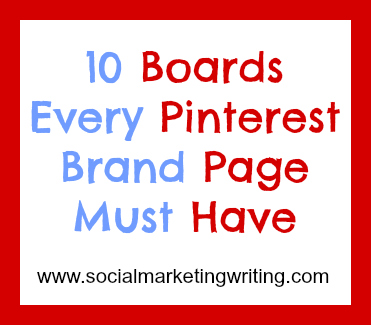Have you created all the essential boards on your Pinterest account? Would you like some creating Pinterest board ideas?
One of the first things you need to do after setting up your Pinterest page is to create all the necessary boards. Boards will help set the tone and make it easy for you to choose and share pins your audience will enjoy.
The right boards can also help you attract more relevant Pinterest followers, as one of the first things visitors see when they visit your profile is the boards. Check out the types of boards every Pinterest brand page must have below…
18 Best Pinterest Board Ideas to Get More Followers, Saves, and Sales
1. Infographics Board:
A study shows that tall images which have a height of about 800 pixels do well on Pinterest.
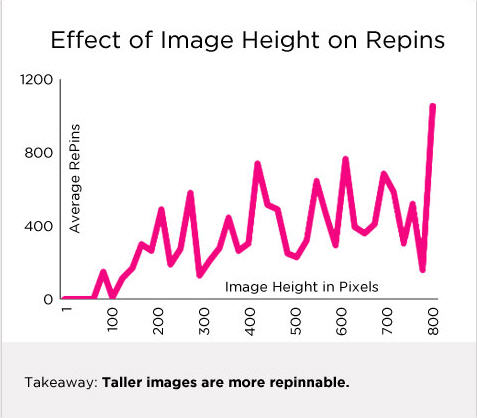
They are more repinnable as they stand out among the smaller images. This is one reason you might have noticed that tall infographics get shared and liked quite regularly.
This is why it’s essential to have an infographics board. It will help you generate engagement and gain followers. You could either create a general one where you share all kinds of infographics or a focused one where you only share pins in your niche. These days you can find infographics on almost any topic.
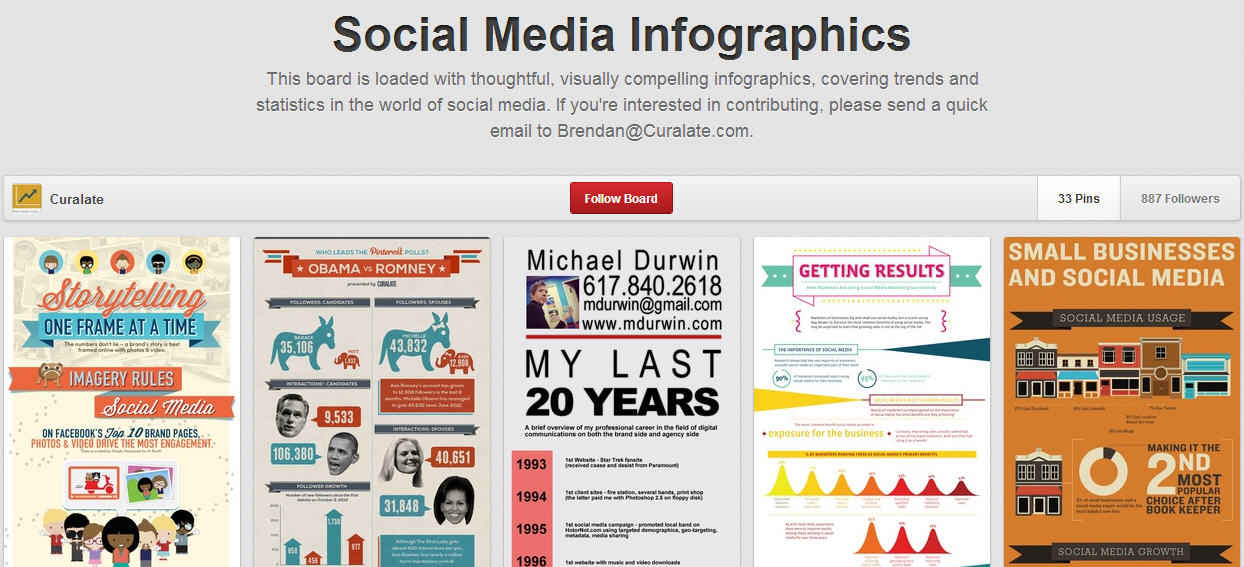
An example is the board Social Media Infographics on Curalate’s Pinterest brand page, where you will notice that the infographics are liked and repinned repeatedly.
2. Quotes Board:
I have noticed that quotes are pretty popular on Pinterest too. So make sure you have a quotes board on your brand page. The key to having a quality quotes board is to stick to quotes that promote your brand. If you’re unsure what, types of quotes will promote your brand, just share motivational ones as they will suit any company or business.
3. DIY Board
DIY is a ubiquitous topic on Pinterest. People are looking for tips on home decor, gardening, cooking, drawing, etc. The topics are endless. You should have a DIY board on your Pinterest profile where you share content that your audience wants to learn about. For example, if you have a furniture design blog, you can share pins that show people how to design different types of furniture. These pins can be a simple image that leads to an article or a collage pin that displays a step-by-step process on the image itself.
For some ideas, check out the DIY | Build and Make board from Ugly Duckling House.
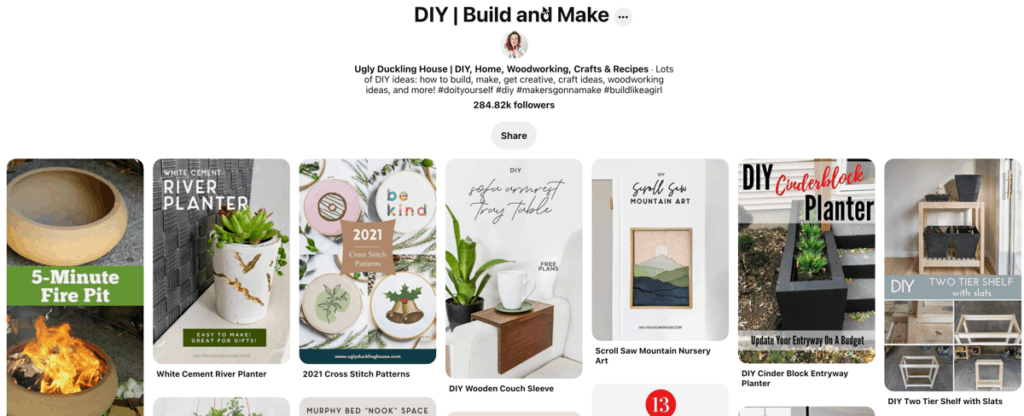
4. Main Board:
Always have a mainboard that projects your company and your brand image. This should be a place where you share content that is relevant to your main product or service. For example, if you are a company that sells cosmetics, you would need a board where you share tips like cosmetics one must have and how to apply makeup better. If you sell or help people adopt pets, you will need to share tips on things like pet sympathy, how to take care of your pets, and things do to before getting a pet.
On this board, share content in the form of blog posts, articles, videos, ebooks, etc., both from your website and others websites. This will give you a lot of quality content to share and will help you build an engaged audience. Also, make sure this board is right at the top to make it easily visible.
5. Relevant Board:
There needs to be a relevant board that is similar to the mainboard. You might think – ‘why do I need this?’ You need this because it allows you to share content from your website again.
To have a great board on Pinterest, you need to share each pin just once, as sharing it multiple times on the same board doesn’t look good. This can limit the exposure your pins get. Therefore having a relevant board where you share your pins again can help them get more exposure. I have written more about how The Gracious Pantry uses this technique exceptionally well in my post 62 Ways to Promote Yourself on Pinterest (it’s the 13th tip).
To have the best effect share the pin on the main board first and then wait for 2 to 3 days and share it on the relevant board, don’t just do it all at once. You can use Tailwind to help with this. It lets you bulk upload pins to multiple boards and pin them at intervals.
6. Humour Board:
Everybody loves a good laugh once in a while. This makes the humor board important. This is a place where you share funny images your audience will enjoy – by this, I mean images relevant to your company and the brand image you want to project.
Sharing images associated with what you do will help you attract your targeted audience and not just any audience, as it isn’t enough to have many followers. It’s more important to have the right followers who are more likely to engage with your pins and buy your products.
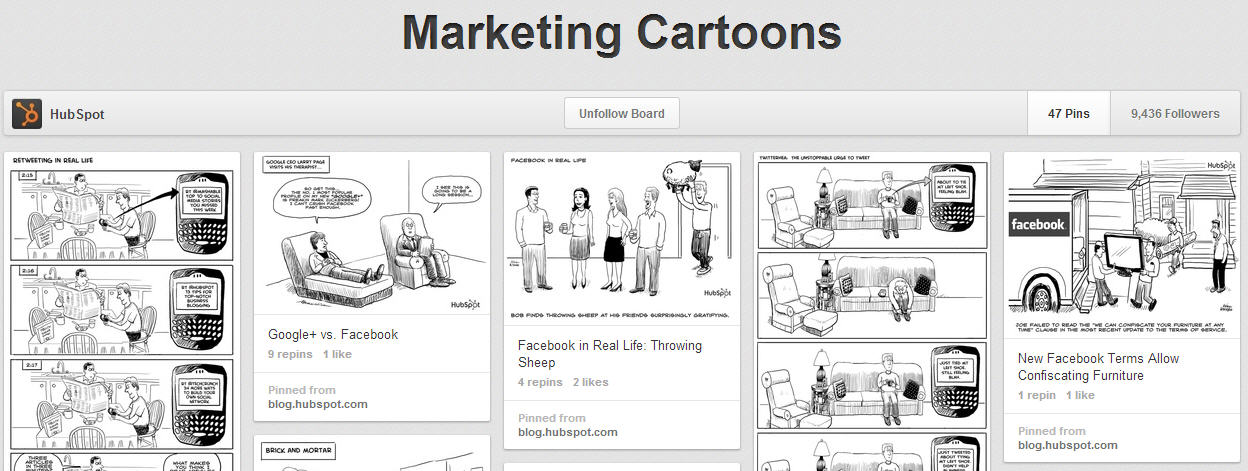
An example is the Marketing Cartoons board on Hubspot’s Pinterest brand page, where they share some funny cartoons. And the beauty of it all is that they share cartoons on marketing which is what they specialize in.
7. A Random Board:
A random board is necessary too. You will often come across pins you like, but they won’t belong to any board. At this time, you will face the dilemma of just ignoring it or sharing it on one of your boards.
My advice would be not to ignore it, but pin it onto a board where you just share all your random pins. You could name the board ‘Random Pins’ or ‘Miscellaneous’ – once you get the time, you can add this pin to another board or create a new board just for pins like this one. You never know how vital that pin could be to you or your audience in the future, and if you ignore it, you might never see it again. So make sure you share it.
8. Secret Board:
Another great place to add your random pins would be a Pinterest secret board. The advantage of adding pins here is that your followers won’t be able to see it. So if it’s something personal or you think your audience is not ready to see, add it here. For more tips on making the most out of secret boards, read my blog post 3 Tips for Using Pinterest Secret Boards.
9. Group Board:
From what I have noticed so far – group boards are amazing! They can help you gain more followers, and they can drive a lot more engagement than regular boards. They also generate significant amounts of traffic. Therefore, make sure you have a group board on your brand page.
In the beginning, you can just invite a few friends and gradually watch it populate as the other contributors add their friends too. All these contributors will add a lot of content, and eventually, their followers will become your followers too. Just make sure you lay down some rules like sharing relevant content, avoiding too much self-promotion, etc. Ensure you’re strict about these rules and evict people who don’t follow them to help set an example, as spam is a common problem on group boards.
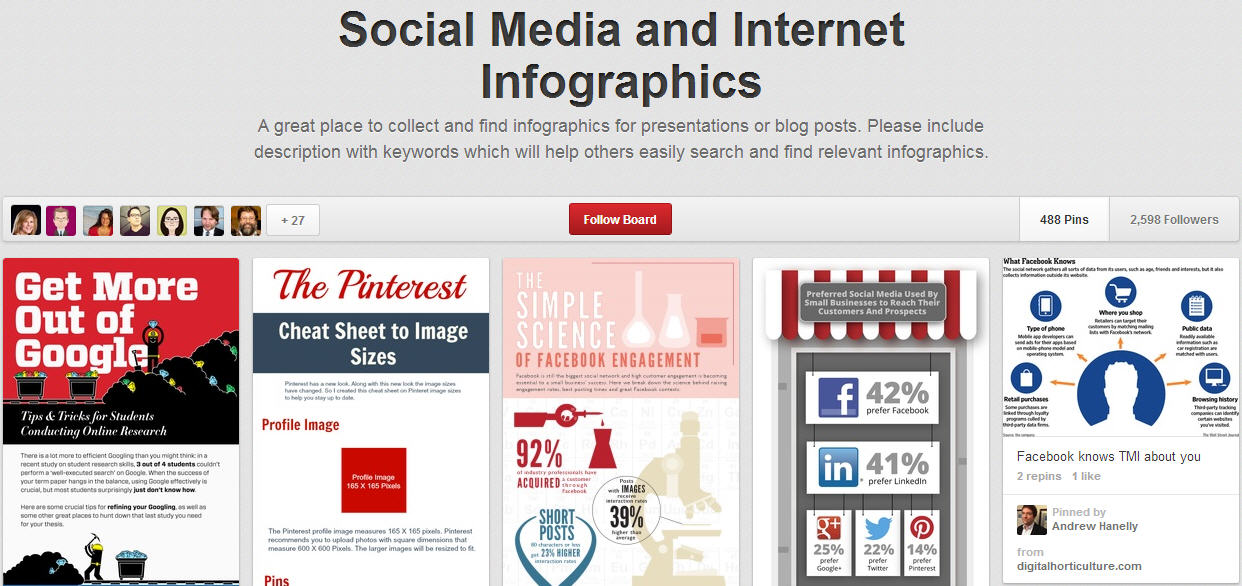
Irene Koehler has a wonderful group board Social Media and Internet Infographics where you will notice that all the pins shared get liked and repinned several times. Create at least one group board like this one.
You can team up with both brands and influencers for these boards.
10. Photo Board:
A photo board is necessary too. This is the place where you share photos and pictures of what happens at your office, events, and home. These photos will help your audience connect with you better. They might also want to work with you as people prefer working with people and not companies they know nothing about. You could also share images of your fans here.
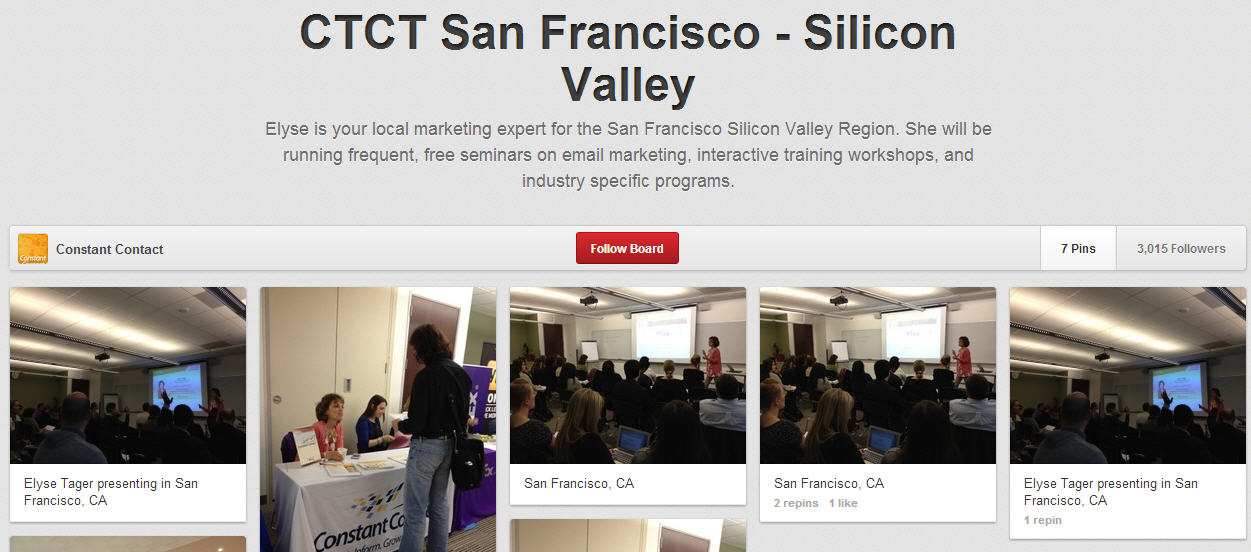
An example is Constant Contact’s board CTCT San Francisco – Silicon Valley, where you will find pictures from one of their events.
11. Products Board:
A products board is necessary too. You can have just one or several of them. This is the only place where you need to share your products. Never try to mix your content boards with your products. They need to be separate.
Let people know what the product does and how it is going to help them in the description. Make sure you add a general description to the entire board too. If you are comfortable revealing the price early on, write down the price on the pin’s description. If you activate rich pins, Pinterest will automatically add the price to the pin.
If you run an online business, you can link to the products. But if the products are available only in-store, you can share the address.
I have written more about promoting products in the post 6 Tips for Using Pinterest for Business.
12. Etsy products:
If you want to get specific with your products board, you can have an Etsy board. Pinterest users love Etsy products. It is one of the top three websites from which people pin images. You can pin products from your store or other people’s stores. But I recommend that you categorize these boards properly as Etsy has a wide range of products. People sell everything from templates to printables to physical products. Here’s an example of an Etsy board from Crochet Jewel.

13. Viral Pins Board
One way to get many saves on Pinterest is to piggyback on a viral pin someone else has created. You can visit your home feed or use a Pinterest analytics tool to see which pins are trending and then pin them onto your Pinterest account. You can create a separate viral pins board and pin all these images there or just distribute them among your other boards. Don’t just pin anything just because it went viral. The visuals you pin should interest your target audience.
Viral pins are a shortcut to beating the Pinterest algorithm without creating a lot of content. But make sure you tag the creator in the description or link to their website.
14. Blogging tips:
A lot of Pinterest’s users are bloggers. If you are targeting this audience, you might want to have blogging tips or a bloggers board. This can again be a very general board or something specific like a lifestyle blogger or video blogger board. An example is the Small Business & Blogging board from Elizabeth Journals.
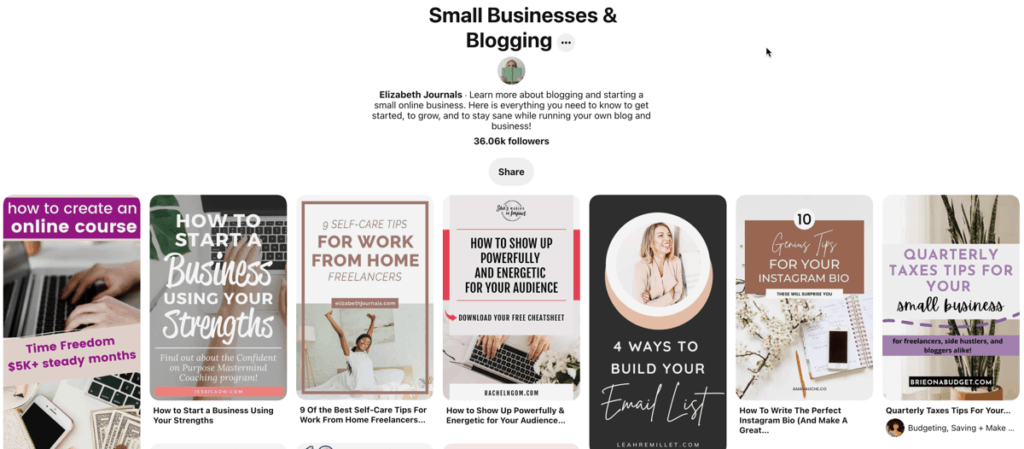
15. Tutorial boards:
A tutorial board is similar to a DIY board. The main difference here is that you will be sharing more step-by-step video pins instead of images. Videos have been doing well on Pinterest since their introduction. These should be vertical videos instead of landscape videos you see on Facebook and YouTube. Here’s an example of a Tutorials board from Polina Bright.
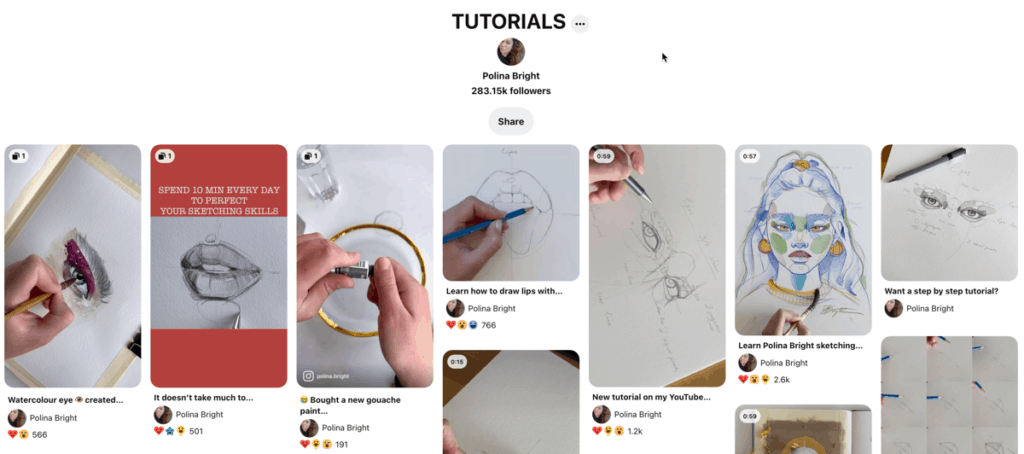
You’ll find drawing and painting video tutorials here.
16. Pinterest tips
Pinterest’s users will want to know how to get better at Pinterest. From my experience managing accounts, I find that Pinterest-related pins get a lot of repins and clicks. You should create a Pinterest tips board if you want to take advantage of all this engagement. On this board, you can share general Pinterest usage tips. But if your audience consists of bloggers or marketers, you can share other pins such as Pinterest blogging tips, Pinterest marketing tips, and ideas on how to make money on Pinterest.
17. Printables
Printables are trendy on Pinterest. If you find a printable your audience could use, you should pin it on your printables board.
18. About me
You can have an about me board where you pin photos of your employees at work. This will help your followers form a better connection with your business. If you are a sole business owner, you can simply post pictures of yourself.
4 Tips for Creating a Pinterest board
Now that you have a lot of Pinterest board ideas, I will share some board creation and optimization tips to help you create boards that generate engagement and followers.
1. Do some Pinterest SEO research
Pinterest might appear like a social network, but it isn’t just that. It’s also a search engine. Think of it as more of a Google image search with some interactive features. This is why you should optimize your pins for the Pinterest search algorithm too by including keywords.
To find keywords, just think about the board idea and type in relevant keywords in the search bar.

Pinterest will then suggest some search terms. You can add the most relevant ones to a list. You can also use the Pinterest ads manager to find keywords. This will also show you the search volume of the keywords.
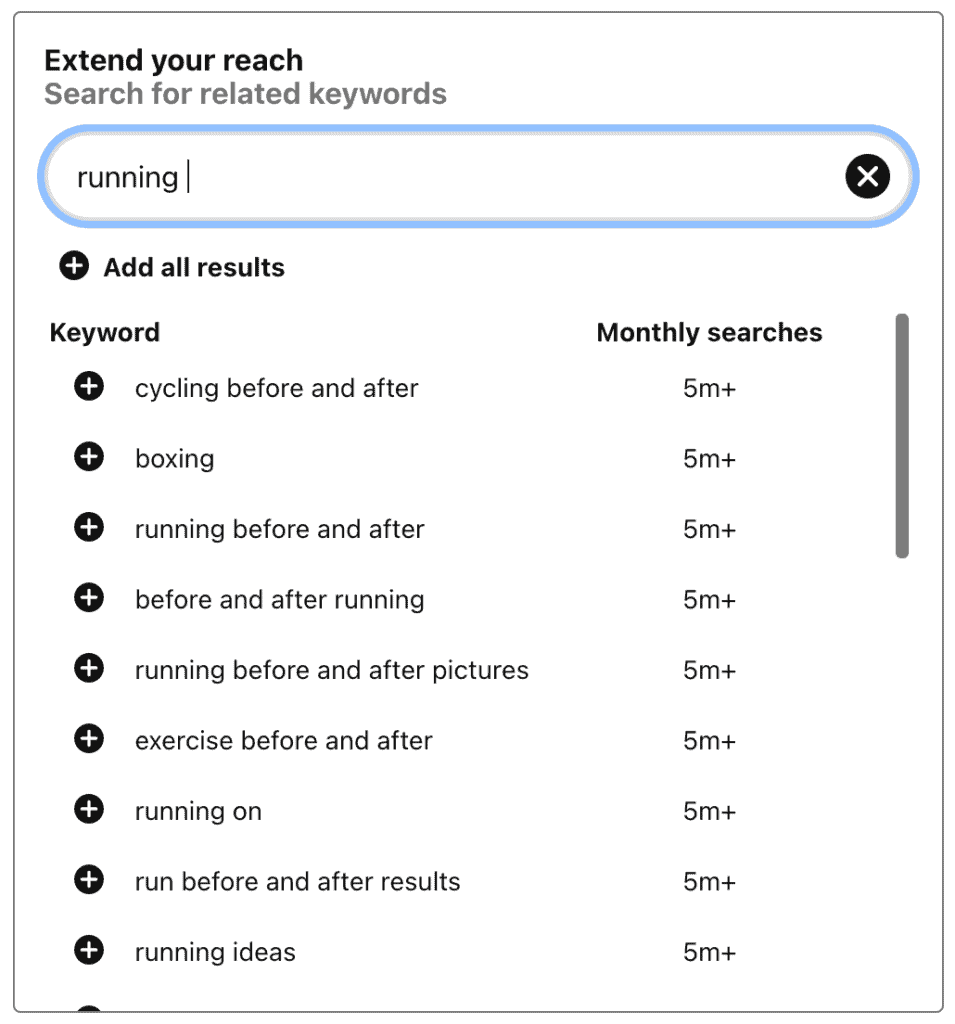
You can use this tool only if you have a Pinterest business account.
2. Brainstorm SEO friendly Pinterest board names
Once you have some keywords, you can brainstorm Pinterest board names. The keywords should creatively fit in the board titles and not look stuffed. Only use one keyword in each title.
Try to come up with clever and witty names here as they can attract more traffic. Relevant keywords will help your boards rank higher and generate more clicks and Pinterest followers.
3. Write the description
Weave some keywords into the descriptions as they play a role in how high your boards rank. Repeat the process and create as many boards as you need. It’s good to have at least ten boards.
4. Come up with a pinning plan
After your boards are ready, you should develop a pinning plan for individual boards and all boards together. What you choose to pin and how often should depend on your Pinterest strategy goals. This could be to drive traffic or sales or to gain followers.
What are your favorite Pinterest board ideas?
Boards are probably Pinterest’s best feature. Pinners love it as it gives them a better experience. On other social networks, people can only follow an entire page. As a result, they come across a lot of content they don’t want to see. This can annoy them, and they might mute a page or unfollow it completely.
Boards help you retain your followers and nurture them better as they’ll only see relevant content. So, take advantage of this and create as many as you can. Don’t worry about having too many. In social media marketing, it’s always better to be specific and deliver a focused message.
For more Pinterest tips, Sign up for our blog updates and get the Free Pinterest Marketing Video Tutorial. It can play a vital role in your Pinterest marketing strategy.
Which boards does every Pinterest brand page need? Have I missed out on any important ones? Please leave your comments below.
If you found the above post on the types of boards every Pinterest brand page must have and think your friends and followers will do too, please share it with them using the share buttons below.
This post was first published on May 7, 2013. It was last updated on June 14th 2021.
